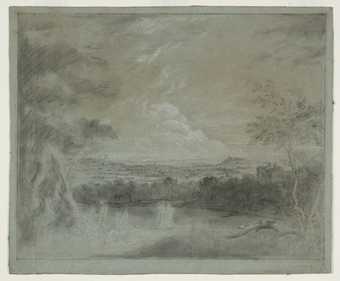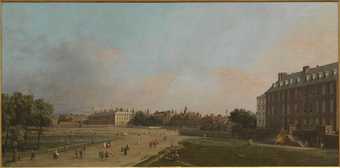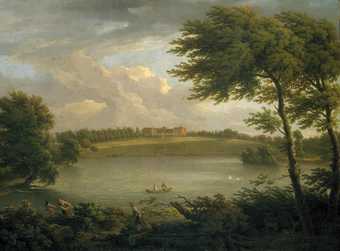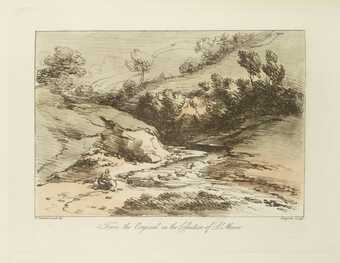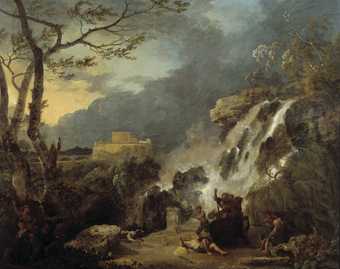
Richard Wilson
Meleager and Atalanta (c.1770)
Tate
Of all the great English landscape painters Richard Wilson has been the least recognised. This is partly because his pictures were so much copied by his pupils and by others with less scrupulous motives and because he himself often made uninspired replicas of his original designs.
The exhibition includes paintings by Wilson’s contemporaries, which show that some years before Canaletto’s arrival in England English landscape painting was by no means negligible. In the seventeenth century, landscape painting in England was almost entirely confined to making views of country houses and ancient ruins in response to the demand from publishers and print sellers, who had a ready public amongst the growing body of antiquarians. The early views were often little more than maps with no attempt at aerial perspective, as in The Panoramic View of Wilton, but painters like George Lambert and the more gifted Samuel Scott, with their sensitive powers of observation, realized the pictorial possibilities of view making and the unifying effect of light and atmosphere.
Canaletto’s visits to England between 1746 and 1755 encouraged English topographical painters, and a comparison of his View of Murano with the View of Westminster by Samuel Scott, with their silvery tones and well knit composition, shows that the two painters had much in common. It is possible that Wilson saw Canaletto’s work before he left for Venice, but the View of Dover shows none of that rich colour and bold, liquid impasto which Wilson learned to use in Italy.
Like most English painters at the time, Wilson felt an urge to study in Italy and to paint in the country so vaunted by the connoisseurs. He spent some months in Venice where, as he noted in one of his letters, he studied the Titians.
The opalescent colour of Venice, the wide expanses of the lagoons, and above all the sunlit Roman campagna, rich with classical associations, stimulated his poetic imagination. The Italian countryside was grander and simpler than the varied and tangled beauties of England and helped him to develop that power of selection and breadth of vision which were already apparent in the View of Dover.
In discussing the influence of Claude and Gaspard Poussin on the development of Wilson’s style it is important to remember the contribution made by the Dutch school. Wilson particularly admired the golden light of Cuyp and like Gainsborough he evidently studied the technique of such painters as Jacob Ruysdael, particularly the treatment of foliage. There was a strong commercial link between England and the Low Countries, and Dutch pictures must have been imported fairly freely.
Wilson also attempted to paint mythological subjects in the Grand Manner, then so popular, and earned this just rebuke from Sir Joshua Reynolds: ‘Our late ingenious academician Wilson has, I fear, been guilty like many of his predecessors of introducing gods and goddesses, ideal beings into scenes by no means prepared to receive such personages’. His landscape was in reality too near common nature to admit supernatural objects. Reynolds, whilst he greatly admired the painting of the storm in the famous Niobe by Wilson, felt that the figures merely made the effect grotesque. It has only been possible to get two examples of Wilson’s mythological pictures for the exhibition, but Meleager and Atalanta, well illustrates Reynolds’s point.
The drawings in the exhibition give further insight into Wilson’s methods of working and include brief jottings which he made on his journeys, detailed studies of plants and trees, and precise, elaborately worked-up compositions, all of which served as material for his pictures.
The pictures in the last section of the exhibition have been chosen to indicate the taste of connoisseurs in Wilson’s day. Wilson learnt from them all, but he allied himself with none. His vision was not sufficiently picturesque, either in the Venetian or in the Dutch sense, to appeal to those who had been taught to admire the mythological pastorals of Zuccarelli or the idealized country life as represented by Cuyp; nor were his subjects sufficiently classical to appeal to patrons who looked mainly for literary allusions and did not appreciate the classic clarity of Wilson’s compositions.
Mary Woodall

